Abstract
Recent research exploring embodied interactions with digital interfaces indicate cognitive and affective implications regarding the processing of visual stimuli when the hands are near to them (hand-proximity effect). In this regard, the present study delves into the affective implications of digital “grabbing”, particularly within the context of affective spatialization by hand dominance. Concretely, the Body Specificity Hypothesis (BSH) suggests that right-handers associate the right space with positivity and the left space with negativity. To test this assumption within an interactive environment, sixty right-handed participants performed lateralized grab interactions with forty pictures (20 positive and 20 negative) displayed at the right or left space of a touchscreen monitor. The results support an interactive positivity bias effect whereby grabbing positive (vs. negative) pictures at the right (vs. left) space was significantly faster. This finding is discussed against the background of the Spatial Affective Interaction (SAI) framework, integrating hand-proximity, affective spatialization, and approach-avoidance mechanisms to understand embodied digital interactions. Limitations include the need for further research on left-handed interactions and decontextualized stimuli. The findings highlight the relevance of considering ergonomics and emotional context in interface design.
Access this chapter
Tax calculation will be finalised at checkout
Purchases are for personal use only
Similar content being viewed by others
References
Wigdor, D., Wixon, D.: Brave NUI World: Designing Natural User Interfaces for Touch and Gesture. Elsevier & Morgan Kaufman, Burlington (2011)
Fabbri, S., Selen, L.P., Van Beers, R.J., Medendorp, W.P.: Flexible visuomotor associations in touchscreen control. Front. Hum. Neurosci. 11, 558 (2017)
Brucker, B., Brömme, R., Ehrmann, A., Edelmann, J., Gerjets, P.: Touching digital objects directly on multi-touch devices fosters learning about visual contents. Comput. Hum. Behav. 119, 106708 (2021)
Qi, Y., Wang, X., He, X., Du, F.: Prolonged subjective duration near the hands: effects of hand proximity on temporal reproduction. Psychon. Bull. Rev. 26, 1303–1309 (2019)
Thomas, L.E.: Action experience drives visual-processing biases near the hands. Psychol. Sci. 28(1), 124–131 (2017)
Cervera-Torres, S., Ruiz Fernández, S., Lachmair, M., Riekert, M., Gerjets, P.: Altering emotions near the hand: approach–avoidance swipe interactions modulate the perceived valence of emotional pictures. Emotion 21(1), 220–225 (2021)
Casasanto, D.: Embodiment of abstract concepts: good and bad in right-and left-handers. J. Exp. Psychol. Gen. 138(3), 351–367 (2009)
de la Vega, I., Dudschig, C., De Filippis, M., Lachmair, M., Kaup, B.: Keep your hands crossed: the valence-by left/right interaction is related to hand, not side, in an incongruent hand response key assignment. Acta Physiol. (Oxf) 142(2), 273–277 (2013)
Kong, F.: Space–valence associations depend on handedness: evidence from a bimanual output task. Psychol. Res. 77(6), 773–779 (2013)
Milhau, A., Brouillet, T., Brouillet, D.: Valence–space compatibility effects depend on situated motor fluency in both right-and left-handers. Q. J. Exp. Psychol. 68(5), 887–899 (2015)
Marchewka, A., Żurawski, Ł, Jednoróg, K., Grabowska, A.: The Nencki Affective Picture System (NAPS): introduction to a novel, standardized, wide-range, high-quality, realistic picture database. Behav. Res. Methods 46(2), 596–610 (2014)
Lang, P., Bradley, M.M.: The International Affective Picture System (IAPS) in the study of emotion and attention. Handb. Emotion Elicitation Assess. 29, 70–73 (2007)
The jamovi project. Jamovi (Version 2.3) (Computer Software) (2022). https://www.jamovi.org
Gallucci, M: GAMLj: General analyses for linear models. (jamovi module) (2019). https://gamlj.github.io/
Torres, S.C., Ruiz Fernández, S., Gerjets, P.: Spatial Affective Interaction (SAI): A Framework for Research on Affective Processing by Manual Interactions with Digital Objects (Manuscript submitted for publication) (2024)
Kauschke, C., Bahn, D., Vesker, M., Schwarzer, G.: The role of emotional valence for the processing of facial and verbal stimuli—positivity or negativity bias? Front. Psychol. 10, 1654 (2019)
Torres, S.C., Gracia Laso, D.I., Minissi, M.E., Maddalon, L., Chicchi Giglioli, I.A., Alcañiz, M.: Social signal processing in affective virtual reality: human-shaped agents increase electrodermal activity in an elicited negative environment. Cyberpsychol. Behav. Soc. Netw. 27(4), 268–274 (2024)
Du, F., Wang, X., Abrams, R.A., Zhang, K.: Emotional processing is enhanced in peri-hand space. Cognition 165, 39–44 (2017)
Cervera Torres, S., Ruiz Fernández, S., Lachmair, M., Gerjets, P.: Coding valence in touchscreen interactions: hand dominance and lateral movement influence valence appraisals of emotional pictures. Psychol. Res. 84, 23–31 (2020)
Acknowledgments
We thank Ulli Hagenlocher, Lisa Fritsch, Kathy El-Majzoub, Duygu Tuncay, and Lorea Versa for their invaluable help. The study was funded by the German Research Foundation (DFG) grant num. CE 426/1-1, awarded to Dr. Torres.
Author information
Authors and Affiliations
Corresponding author
Editor information
Editors and Affiliations
Ethics declarations
The authors have no competing interests to declare that are relevant to the content of this article.
Rights and permissions
Copyright information
© 2024 The Author(s), under exclusive license to Springer Nature Switzerland AG
About this paper
Cite this paper
Torres, S.C., Ruiz Fernández, S., Gerjets, P. (2024). Positive-Right and Negative-Left: Affective Spatialization by Digital “Grab” Interactions. In: Stephanidis, C., Antona, M., Ntoa, S., Salvendy, G. (eds) HCI International 2024 Posters. HCII 2024. Communications in Computer and Information Science, vol 2114. Springer, Cham. https://doi.org/10.1007/978-3-031-61932-8_26
Download citation
DOI: https://doi.org/10.1007/978-3-031-61932-8_26
Published:
Publisher Name: Springer, Cham
Print ISBN: 978-3-031-61931-1
Online ISBN: 978-3-031-61932-8
eBook Packages: Computer ScienceComputer Science (R0)




